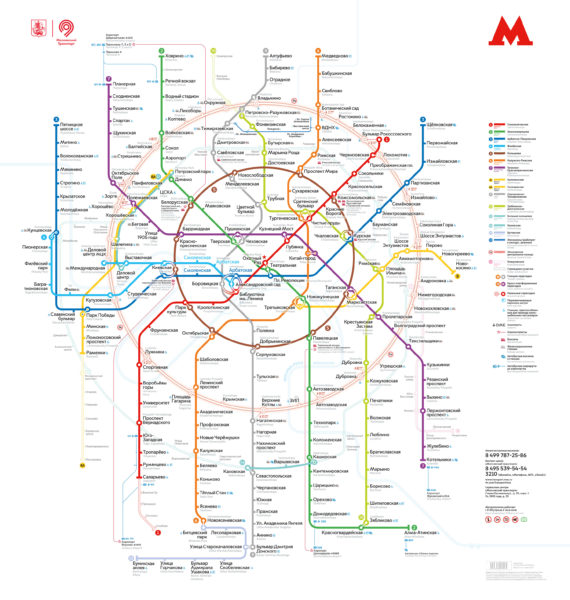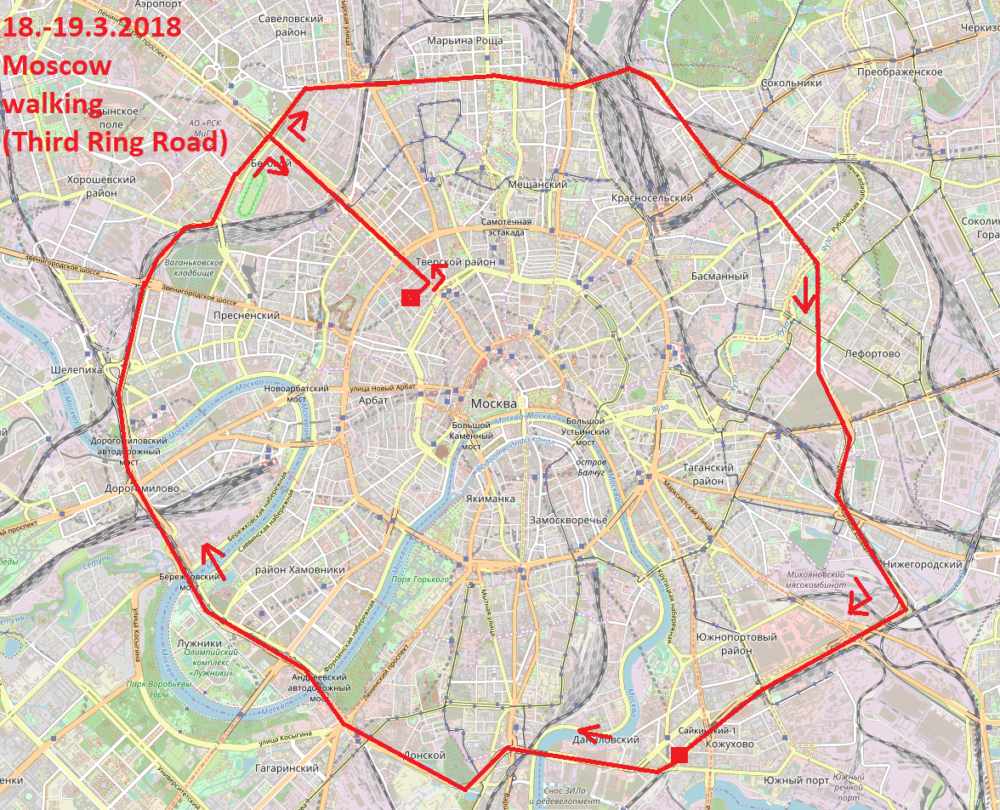MOSCOW
SELECTED KEY* PERFORMANCES
* read more about different types of performances in East by Northeast HERE ; to see the full list of all performances go HERE
Performing the Red Square and the Central Squares of Moscow (walking)
28/2/2018 Moscow, RU
Performing the Boulevard Ring (Bulvarnoye Koltso) (walking)
1/3/2018 Moscow, RU
In the two very first performances of the East by Northeast project I have (1) walked around the Red Square and the Central Squares of Moscow and (2) walked around the Boulevard Ring (Bulvarnoye Koltso). It seemed fitting, to begin the research on Moscow’s circularity ‘in the beginning’ – in the place from where its successive ring roads emerge: the Red Square. This old market square was the focal center not only of the medieval but also and maybe even more importantly, of the socialist Moscow as “the supreme shrine of the regime, not just for the city but for the entire country and for the communist system worldwide.” (French 1995: 12)
In my performance, I did nothing spectacular – in no way unusually dressed, without being too fast or too slow, without any special expression, I once walked around the square. The same strategy I followed with the first two rings, which are encircling the very center of the city: Central Squares of Moscow and the Boulevard Ring.


AUDIODIARY 27/2/2018
AUDIODIARY 28/2/2018
_
Metro III: Moscow (metro)
15/3/2018 Moscow, RU
The Metro III: Moscow was a continuation of my performance-research series (preceding were Prague and London and following Beijing). In these works, I was not acting as a specialized metro analyst. I was not making detailed records about the efficiency or appearance of the metro or analyzing in detail people in it, or if so, these were only sidenotes, small observations as part of my flow of thoughts in the diary. Rather, this was my personal adventure, an invisible urban game, an attempt to merge my body with the machine ensemble of the metro system. Each of the project installments had slightly different rules but there were some basics: to enter the system at the beginning of the day and leave it with the last train (biological needs put aside), to write notes in the notebook, not to use the phone.
When being inside of the Moscow metro system, I perceived it no longer (only) as a means, a technology, which was supposed to get me somewhere as I was not on a way anywhere. As a result, my performance somewhat inconspicuously changed in relation to the respective machine ensemble. I did not provoke anybody, paid my ticket so to avoid any unwanted attention from the ticket controllers, did not wear unusual clothes, etc. On the other hand, within the constraints of my ‘good metro user’ persona, I cared less about my performative character. I did not mind to sleep in carriages, lazily stroll on platforms amidst the rushing crowds or to enjoy my lunch there.
The rules of the whole day art performance created the notion of safety – I knew I will be staying inside of the system until it closes, that I did not have to worry about the food and water (as I took it with me), that I could sit or sleep almost anytime I wanted. It was a similar feeling – though still different – as being at home which is also why my way of performing myself slightly changed from my public space character into a one I would present rather in a private space. This feeling I had with other urban performances too but it was especially strong inside of the metro.
Map of Moscow Metro system March 2018
_
Performing the Third Ring Road (walking)
18-19/3/2018 Moscow, RU
In this action, I walked around yet another and an even wider ring of Moscow. This was the largest ring which it was still possible to walk on, taking into account the scale and conditions of my research. The Third Ring Road (Tretye Transportnoye Kolco, TTC) is a 35km long orbital highway for cars. There is often no pathway for pedestrians and in segments, the beltway also disappears in tunnels under the ground. In comparison to the Garden Ring, there is no public transport service which operates all the way around. The origins of the Ring dates back to the Moscow 1935 General Plan (Chernishev – Semenov [1935]) with construction beginning in 1960. It was fully completed only in 2005
Urban geographer Robert Argenbright calls the TTC a “state-sponsored obsession with the automobile” (Argenbright 2003), pointing out its negative impact on the appearance of the city and the environment. The TTC “reduces the amount of public space available” and “endangers civil society”. (Ibid.) From this perspective, my walk could be also seen symbolically, as a kind of a march for healthier/more pedestrian-oriented cities.
For Performing the Third Ring Road (walking), I decided to experiment and invite the audience to take part as well. I was offering people to witness the performance through the WhatsApp mobile application and to contact me any time daytime during the two days of the walk. This opportunity I advertised through email and open Facebook event. With whoever would contact me, I was ready to have an audio or video call or to use the WhatsApp’s function of “location sharing”, where the receiver could observe my movements on a digital map in real-time. And few people have indeed contacted me. This way I tried to provide more direct experience than through an online diary or subsequent gallery exhibition.